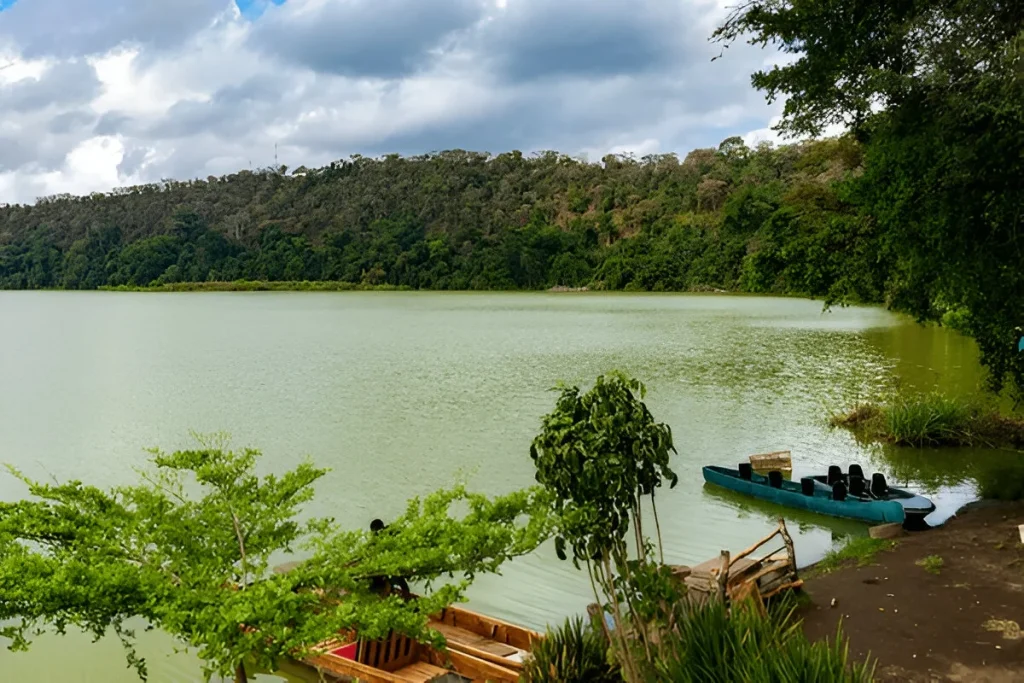Lake Duluti (Out-door in Arusha)
Lake Duluti, a stunning crater lake nestled at the foot of Mount Meru, was formed by a volcanic eruption that created the crater basin. Sharing a volcanic vent with Mount Meru and Mount Kilimanjaro, this lake is a testament to the region’s geological history. While the exact depth of the lake remains unclear, some estimates suggest it could be up to 9 meters deep, though this figure is likely an understatement for a crater lake of its size. Other sources claim the lake’s depth reaches 700 meters from the rim and 200 meters from the surface, though official data is still lacking. Despite the uncertainty surrounding its precise measurements, Lake Duluti remains an ideal destination for a tranquil day trip from Arusha, offering breathtaking views and a serene environment for nature lovers and explorers alike.

Activities in Lake Duluti.
- Birdwatching
- Canoeing/Kayaking
- Spot fishing
- Nature Walk in the forest
- Picnicking
Climate.
Lake Duluti has a mild and humid climate throughout the year, influenced by its location in the Arusha region. Temperatures typically range between 15°C to 28°C (59°F to 82°F), with cooler mornings and evenings. The area experiences two rainy seasons: the long rains from March to May and the short rains from November to December, bringing lush greenery and a refreshing atmosphere. The dry season from June to October offers clear skies and pleasant weather, making it the best time for outdoor activities like canoeing, birdwatching, and hiking.
Best Time to Visit.
The best time to visit Lake Duluti is year-round. Still, the dry season from June to October is ideal for canoeing, hiking, and birdwatching, with clear skies and comfortable temperatures. The wet season from November to May brings lush greenery and a cooler atmosphere, making it perfect for nature lovers and photographers.

How to Get There.
Lake Duluti is a volcanic crater lake located in Meru District, approximately 14 km from Arusha city center and just 1.3 km off the Arusha-Moshi highway near Tengeru. The lake is easily accessible by car or taxi, and it takes 20–30 minutes to reach via the Arusha-Moshi highway, which has a turnoff at Tengeru.
For those arriving from Kilimanjaro International Airport (JRO), the lake is 35 km away, requiring about 45 minutes of travel by car or taxi.
Public transport options include buses from Arusha to Tengeru, followed by a short taxi ride or a walk to the lake. Alternatively, many guided tours offer transportation along with various activities at the lake.
Facts About Lake Duluti
- Lake Duluti Forestry Reserve covers about 19 hectares (47 acres) of land.
- Lake area size of 0.5 Square kilometers
- Depth of 200 meters estimations
- Duluti is the crater lake
- Duluti is an endorheic lake
Tragic Story of the Name Duluti.
Long ago, in a small village near present-day Lake Duluti, a young woman named Nduluti lived a peaceful life. She was known for her beauty, intelligence, and strong spirit. However, her fate took a dark turn when her family and elders demanded she undergo Female Genital Mutilation (FGM), a deeply rooted tradition in her community.
Nduluti, fearing for her life and future, refused to accept this painful practice. She pleaded with her family, but her cries fell on deaf ears. When the day of the ceremony arrived, she made a desperate decision—to run for her freedom.
Under the cover of darkness, she fled into the forest, her heart pounding as she heard the voices of her pursuers behind her. She ran and ran until she reached the edge of a deep volcanic crater, where the waters shimmered in the moonlight.
With no escape, and knowing that capture would mean unbearable suffering, she whispered a final prayer and threw herself into the lake. Her family and the villagers searched for her body for days, but it never surfaced. Some say the lake swallowed her whole, protecting her from the cruel fate she sought to escape.
Others believe her spirit became one with the waters, and she still watches over the lake, protecting those who visit. The lake remains a symbol of resistance and freedom, a reminder of one woman’s courage to defy tradition, even at the cost of her own life.














